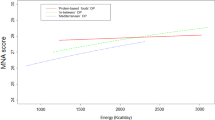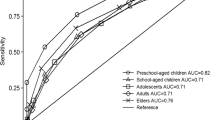Abstract
Background/Objectives:
The aim of this study was to evaluate the estimated energy, nutrient and food intake from the suggested trans-European methodology for undertaking representative dietary surveys among schoolchildren: 2 × 24-h dietary recalls (24-HDRs) combined with a food-recording booklet (FRB), using EPIC-Soft pc-program (the software developed to conduct 24-HDRs in the European Prospective Investigation into Cancer and Nutrition (EPIC) Study), against a 7-day food-record (7-dFR) method among Danish schoolchildren.
Subjects/Methods:
A total of 74 children aged 7–8 years and 70 children aged 12–13 years were recruited through the Civil Registration System in Denmark. Each child and one of their parents completed two face-to-face 24-HDRs, combined with optional use of a FRB, followed by a 7-day-estimated FR.
Results:
Energy intake was significantly higher with the 24-HDR method than with the 7-dFR method for both age groups. Mean energy intake was 6% higher for the youngest (P=0.02) and 11% for the oldest children (P=0.01); underreporting of energy occurs among the oldest children, being less present with the 24-HDR method. The intakes of carbohydrate and dietary fiber (absolute and related to energy) were significantly higher with the 24-HDR than with the 7-dFR for both age groups (P<0.001). No significant differences between the two methods were observed for absolute intake of fat and added sugar between both age groups, and for intake of protein among the 7- to 8-year olds. The percentage of energy intake from fat from the 24-HDR, however, was significantly lower for both age groups and for energy intake from added sugar for the 12- to 13-year olds.
Conclusions:
The 2 × 24-HDR method compared with the 7-dFR yields relatively good values on the group level for many macronutrients and foods. However, some differences in estimated intakes of macronutrients suggest the need to carefully adapt the tools to be age and country specific. There is a tendency for parents and schoolchildren to report a healthier diet with the 24-HDR than with the FRs; this results in some concern about the method and has to be studied further.
This is a preview of subscription content, access via your institution
Access options
Subscribe to this journal
Receive 12 print issues and online access
$259.00 per year
only $21.58 per issue
Buy this article
- Purchase on Springer Link
- Instant access to full article PDF
Prices may be subject to local taxes which are calculated during checkout
Similar content being viewed by others
References
Andersen LF, Lioret S, Brants H, Kaic-Rak A, de Boer EJ, Amiano P et al. (2011). Recommendations for a trans-European dietary assessment method in children between 4 and 14 years. Eur J Clin Nutr 65 (Suppl 1), S58–S64.
Biró G, Hulshof KFAM, Ovesen L, Amorim Cruz JA (2002). Selection of methodology to assess food intake. Eur J Clin Nutr 56 (Suppl 2), S25–S32.
Black AE (2000a). Critical evaluation of energy intake using the Goldberg cut-off for energy intake:basal metabolic rate. A practical guide to its calculation, use and limitations. Int J Obes 24, 1119–1130.
Black AE (2000b). The sensitivity and specificity of the Goldberg cut-off for EI:BMR for identifying diet reports of poor validity. Eur J Clin Nutr 54, 395–404.
Brussaard JH, Löwik MRH, Steingrímsdóttir L, Møller A, Kearney J, De Henauw S et al., for the EFCOSUM group (2002). A European food consumption survey method conclusions and recommendations. Eur J Clin Nutr 56 (Suppl 2), S89–S94.
Burrows TL, Martin RJ, Collins CE (2010). A systematic review of the validity of dietary assessment methods in children when compared with the method of doubly labeled water. J Am Diet Assoc 110, 1501–1510.
Goldberg GR, Black AE, Jebb SA, Cole TJ, Murgatroyd PR, Coward WA et al. (1991). Critical evaluation of energy intake data using fundamental principles of energy physiology: 1. Derivation of cut-off limits to identify under-recording. Eur J Clin Nutr 45, 569–581.
Lillegaard ITL, Løken EB, Andersen LF (2007). Relative validation of a pre-coded food diary among children, under-reporting varies with reporting day and time of the day. Eur J Clin Nutr 61, 61–68.
Livingstone MBE, Robson PJ (2000). Measurement of dietary intake in children. Proc Nutr Soc 59, 279–293.
Livingstone MBE, Robson PJ, Black AE, Coward WA, Wallace JMW, McKinley MC et al. (2003). An evaluation of the sensitivity and specificity of energy expenditure measured by heart rate and the Goldberg cut-off for energy intake: basal metabolic rate for identifying mis-reporting of energy intake by adults and children: a retrospective analysis. Eur J Clin Nutr 57, 455–463.
Livingstone MBE, Robson PJ, Wallace JMW (2004). Issues in dietary intake assessment of children and adolescents. Br J Nutr 92 (Suppl 2), S213–S222.
McPherson RS, Hoelscher DM, Alexander M, Scanlon KS, Serdula MK (2000). Dietary assessment methods among school-aged children, validity and reliability. Prev Med 31, S11–S33.
Nordic Nutrition Recommendations (2004). Integrating Nutrition and Physical Activity, vol. 13. Nordic Council of Ministers: Copenhagen.
Rothausen et al. Evaluation of estimated energy intake from 2 × 24-h recalls and a 7 day food record in children by use of objective measurements of energy expenditure (in preparation).
Sobo EJ, Rock CL (2001). ‘You ate all that!?’: caretaker-child interaction during children assisted dietary recall interviews. Med Anthropol Q 15, 222–244.
Trolle E, Amiano P, Ege M, Bower E, Lioret S, Brants H et al. (2011). Feasibility of 2 × 24-h dietary recalls combined with a food-recording booklet, using EPIC-Soft, among schoolchildren. Eur J Clin Nutr 65 (Suppl 1), S65–S76.
Acknowledgements
We thank the interviewers in Denmark, Anne Arendt, Mia Hjort Frandsen and Inger Merete Licht Hansen, and the data management team, Karsten Kørup, Henrik Hartkopp, Karin Hess Ygil and Tue Christensen. We also thank the participating children, parents and other proxy persons. The content of this article reflects only our views, and the Community is not liable for any use that may be made of the information contained therein. The Community funding under the Sixth Framework Program for the ‘European Food Consumption and Validation’ Project is acknowledged (FOOD-CT-2006-022895).
Author information
Authors and Affiliations
Consortia
Corresponding author
Ethics declarations
Competing interests
The authors declare no conflict of interest.
Rights and permissions
About this article
Cite this article
Trolle, E., Amiano, P., Ege, M. et al. Evaluation of 2 × 24-h dietary recalls combined with a food-recording booklet, against a 7-day food-record method among schoolchildren. Eur J Clin Nutr 65 (Suppl 1), S77–S83 (2011). https://doi.org/10.1038/ejcn.2011.90
Published:
Issue Date:
DOI: https://doi.org/10.1038/ejcn.2011.90
Keywords
This article is cited by
-
Comparison of two food record-based dietary assessment methods for a pan-European food consumption survey among infants, toddlers, and children using data quality indicators
European Journal of Nutrition (2015)
-
Rationale and methods of the European Food Consumption Validation (EFCOVAL) Project
European Journal of Clinical Nutrition (2011)
-
Feasibility of 2 × 24-h dietary recalls combined with a food-recording booklet, using EPIC-Soft, among schoolchildren
European Journal of Clinical Nutrition (2011)
-
Feasibility of repeated 24-h dietary recalls combined with a food-recording booklet, using EPIC-Soft, among preschoolers
European Journal of Clinical Nutrition (2011)
-
The European Food Consumption Validation Project: conclusions and recommendations
European Journal of Clinical Nutrition (2011)



